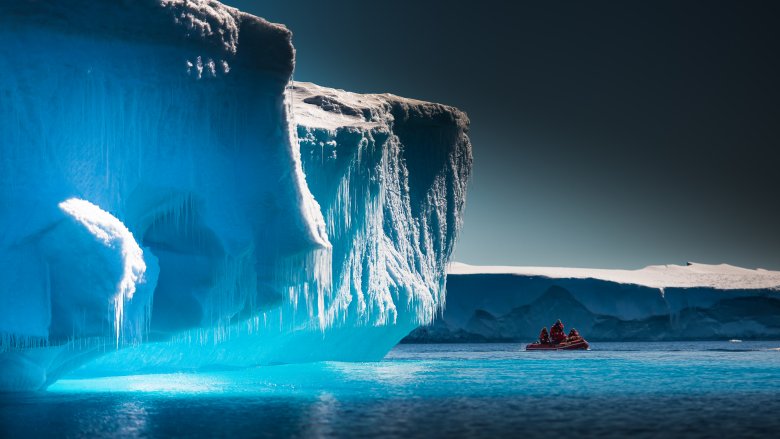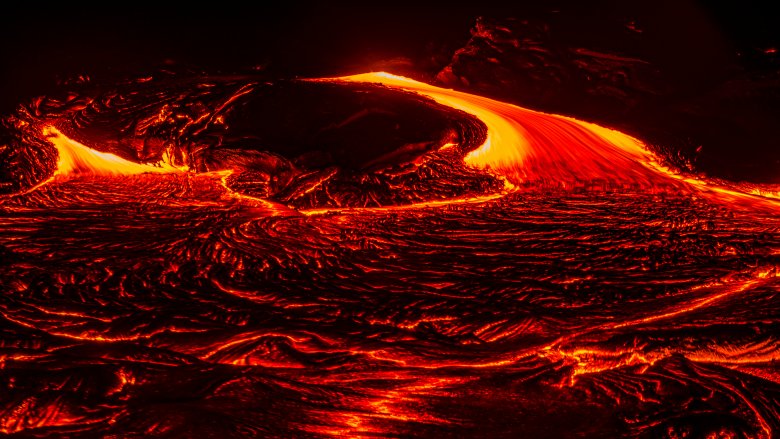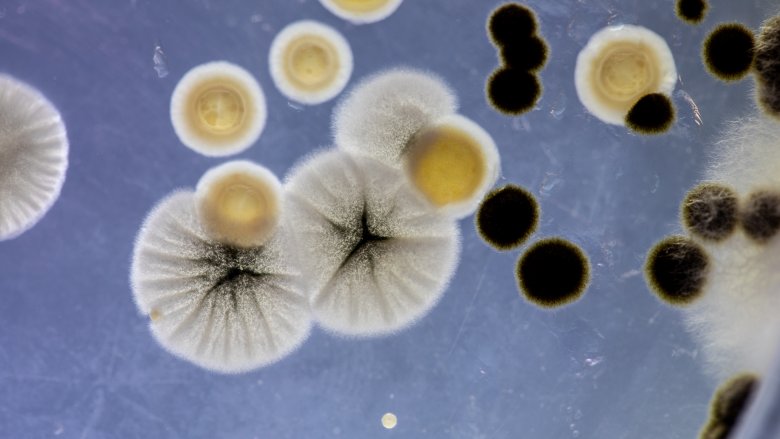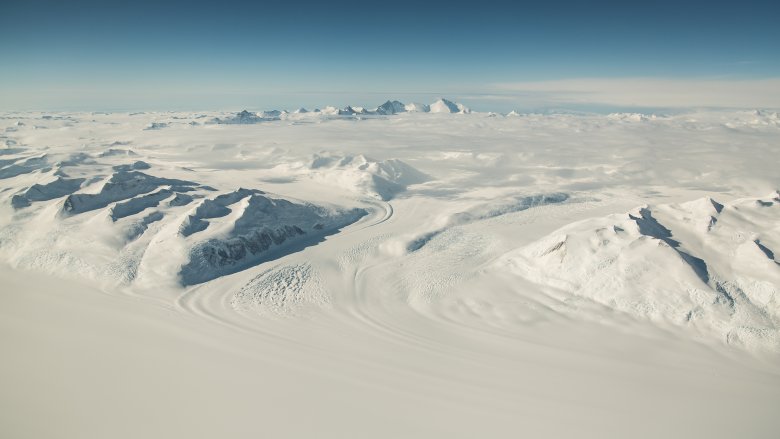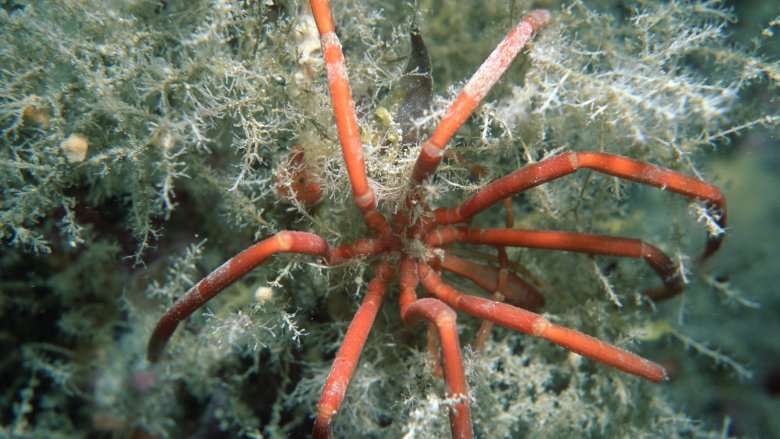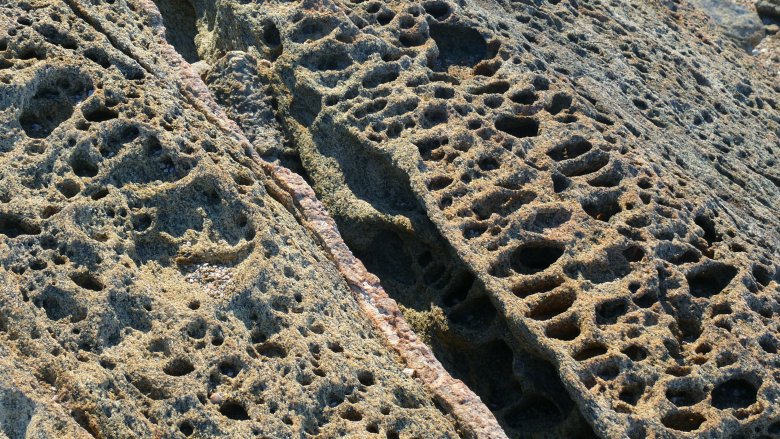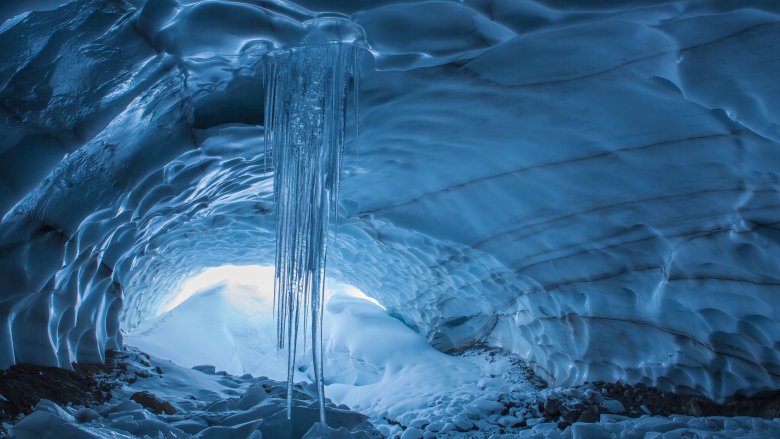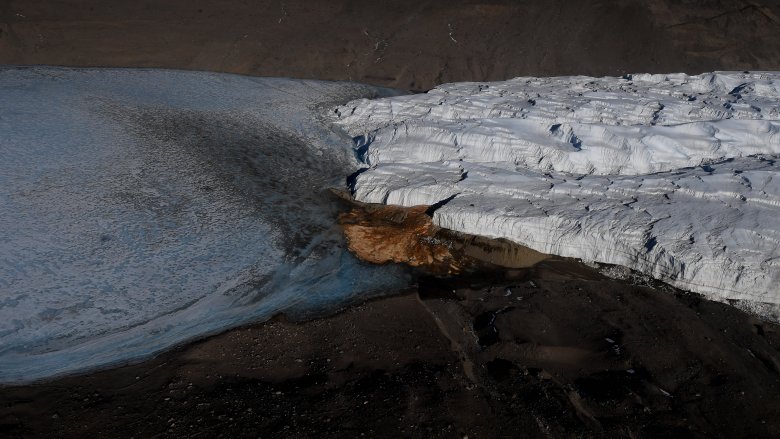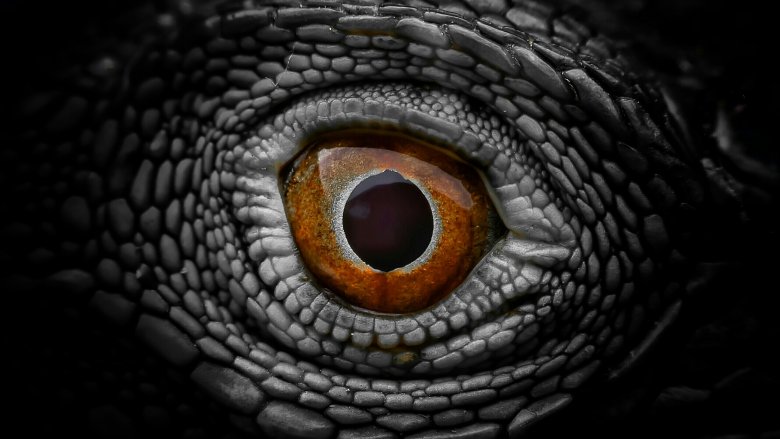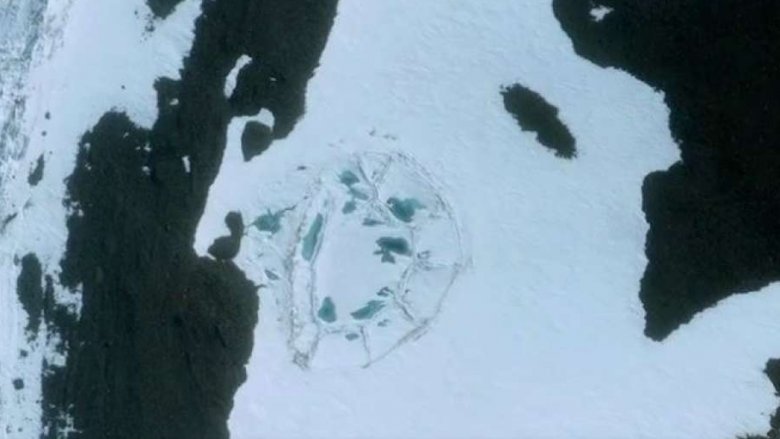Frozen Treasures Found In The Depths Of Antarctica
As far as mysterious places go, Antarctica has a lot going for it. For one thing, it's hard to get there. Unless you're willing to endure the full stowaway experience, which is pretty freaking dangerous, you're either going to need to be extraordinarily wealthy or an accomplished scientist to set foot on Antarctica's icy shores. The remoteness of Antarctica alone provides a natural barrier to people sniffing about and learning what makes the place tick. On top of that, there's just something about a giant continent of ice that captures the imagination. Antarctica is a hotbed (ironic, really) for folklore and supernatural story-telling.
Setting all that made-up stuff aside, discoveries of scientific, historical, and economic significance happen in Antarctica all the time, and one polar researcher described Antarctica as "the least understood continent on Earth." Here are some of the wildest frozen treasures found in the chilly depths of Antarctica.
Antarctica, an island of ice and fire
Antarctica is a remote enough chunk of the Earth as it is, but the speckle of tiny Antarctic islands surrounding the continent is ridiculously remote. Some of these islands are almost impossible to get a plane to fly over, let alone land on. One such speck on the map is Saunders Island, lying around 1,000 miles off the eastern edge of Antarctica's frigid coastline. Researchers analyzing high-resolution South Pole satellite imagery spotted something unusual about Saunders Island — or more specifically, its largest mountain, Mount Michael.
Usually, this mountain is covered in a dense blanket of cloud, so we know very little of its composition or topology. However, very occasionally, the skies clear over Saunders Island, and it was satellite imagery captured on one of those rare days that revealed an unexpected glowing orange patch at the mountain's peak.
They'd found a bona fide hell vista of liquid mineral terror, aka a huge lake of bubbling lava. Now it's worth pointing out, we're not just talking about a humble crater here. We're talking a full-blown 700-foot lava swimming pool that a Targaryen would be proud to do laps in. As far as we know, only seven other lava lakes exist. Not surprisingly, geologists are keen to learn more about this odd mountain at the end of the world, but it'll likely be several years before a surveillance aircraft can get there to take a closer look.
Life, uh, finds a way in Antarctica
Anyone who's seen Encino Man knows that weird things get trapped in ice, from mammoths to cave dudes with surprisingly well-conditioned hair. Folk tales of odd discoveries in Antarctica's icy depths abound. If every far-fetched tale were to believed, Antarctica is a frostbitten theme park of oddly misshapen skulls, secret Nazi bases, and lost Atlantean cities, all jumbled together with the occasional Antarctic ape wandering around taking cute Instagram selfies.
All that stuff is, of course, a big steaming bowl of distilled banana oil in Just Didn't Happen Sauce. But weird stuff is found in the ice all the time.
A long-dormant volcano, Mount Erebus rises over 12,000 feet over Antarctica's summit plateau. Antarctica is bleak. But the top of that mountain makes bleak look inviting. Nothing lives there — or so scientists thought, until 2011. In a chain of volcanic ice caves, scientists discovered a unique microbe. Starved of any other nutrients, these little micro-gremlins evolved a way to chow down on a diet of rock and trace metals. As Jeff Goldblum famously said, "Life, uh, finds a way." In what sounds like a great lead-in to a B-grade Antarctica horror movie, one of the investigating scientists said, "We feel that these ice caves deserve a role in the ... sites that we study for deep, dark environments." Have none of these scientists seen The Abyss?
What lies beneath Antarctica
This is probably not a Jeopardy-winning factoid, but just to recap for those not big on geology, the continent of Antarctica is encased in a thick layer of nearly impenetrable ice. As for what lies beneath it? Until recently, the consensus was that you'd find, well, a lot more ice. And if you kept digging, the thinking was that you'd hit "tectonic block" — basically just solid, rigid, featureless rock.
In 2018, enhanced satellite imaging revealed something far cooler. Beneath all that ice lies a geological jigsaw puzzle. Some of the rock down there resembles bedrock you'd find in Australia. Other rocky remnants closely resemble India's geological foundations. There's even a variety of seafloor remnants.
We don't know precisely when this occurred in our planet's history (it could have happened as far back as 1 billion years ago), but lying beneath Antarctica's icy cover are the torn-up remnants of an ancient supercontinent — a forgotten chunk of our planet before Pangaea's drift doomed it to an icy grave. As for the flora and fauna that once lived on this lost continent, we'll likely never have a complete picture.
Antarctica is home to horrifying ice critters
The oceanic waters under the Antarctic ice fields are cold enough to kill an adult human in a few minutes. Despite nature's none-too-subtle warning that it might not be a good idea to go for a dip, in 2016, a team of intrepid researchers set out to explore a deep oceanic channel almost a mile under the ice. Their six-month photographic mission: to explore strange new aquatic life forms, preferably while managing to avoid freezing their extremities off.
What they found was stunning. They discovered a lush ecosystem of exotic life forms thriving beneath the ice in near-total inky blackness. Many of these creatures are unknown to science.
One intriguing (and yes, abjectly horrifying) discovery was gigantic dinner plate-sized sea spiders (above), which breathe and digest food through their legs. Now there's an image. Scientists are still trying to figure out exactly how these creatures grow so large in such inhospitable conditions — a noble inquiry given the first question for many might run more along the lines of how to kill them with fire from a great distance.
Ancient fossil forests
Over a century ago, one of the first Antarctic explorers reported finding fossils of large plants only a few hundred miles from the South Pole. His findings were dismissed as the delusional ramblings of a man doomed to die a miserable, chilly death, but the explorer's discovery was eventually vindicated.
A complete picture of how Antarctica has changed over time is still unclear, but we now know that 55 million years ago, it was covered in forest, and as little as 12 million years ago the continent was covered in tundra. In 2016, a team of researchers scaled McIntyre Promontory, a bleak mountain jutting out of Antarctica's glacial ice fields, and began sifting through the scree of sedimentary rock. Thirteen fossil fragments were recovered, some belonging to trees that grew in Antarctica over 250 million years ago. The ancient Antarctic trees covered the landscape, and their existence has baffled plant paleontologists. Somehow these extremely resilient trees were capable of surviving for months in complete darkness. This is something that trees as we understand them now simply shouldn't be able to do. How they managed to pull it off, for now at least, remains a scientific mystery.
Antarctica's uber-hole
The 1970s were a tempestuous time. Henry Winkler was searing an indelible mark on pop culture as the indomitably cool Fonz, and the blinged-up behemoth of disco fever was marching roughshod across the hearts and minds of a body hair-obsessed and tan generation. But something far more scientifically edifying was happening behind the scenes: For the first time, scientists gained access to satellite imagery. The world could be scrutinized like never before.
Satellite pictures of one particular ice pack floating out on the Lazarev Sea, off the Antarctic coast, left greasy-haired scientists perplexed and reaching for their Marlboro menthols. A huge hole pierced the glacier. Surrounded by thick ice and in frigid Antarctic cold, this massive, 3,700-square-mile hole just shouldn't have been there. And no one could arrive at a plausible explanation for how it formed.
In the following decades, scientists watched the hole repeatedly disappear and reappear. Sometimes it would remain small. At other times, it would rapidly expand to enormous dimensions and then, just as quickly, fill over. The hole was last seen in 2017, and it was truly massive, expanding to an area the size of Ireland. While the scientific community still has no definitive answers, the prevailing theory is that the huge hole was formed by violent polar cyclones. It could be ice trolls, but ... probably the cyclone thing.
A gory waterfall of terror in Antarctica
This nasty stain on the pristine Antarctic landscape was first encountered way back in 1911 when a team of stalwart Australian scientists stumbled across the Blood Falls. It was hard to miss. A slow-flowing stream of deep red slurry (half water, half ice) carves its way through the pristine, white ice and then slops horrifically down a rocky outcrop, leaving a gory, slimy trail of apparent viscera in its wake.
The explorers theorized (presumably after a few stiff drinks) that the gory spectacle might be caused by an unusual kind of algal bloom, but this was roundly dismissed given that no other life was to be found in the area. The phenomenon was consigned to the category of "just another weird thing that happens in Antarctica." And there it remained for over 100 years.
In 2017, scientists from the University of Alaska put the mystery to rest. Using radio-echo sounding, the researchers were able to trace the path of the bloody water to a hidden, subterranean reservoir of iron oxide-rich water, trapped beneath the ice for over a million years. Cracking in the ice gradually releases this reassuringly non-cursed water, which turns bright red (essentially "rusting") the moment it comes into contact with the air.
The Krakenzilla of Antarctica?
Any tinfoil hat-wearing graduate of the School of Advanced Fruitloopery will tell you Antarctica is a maelstrom of cryptozoological happenings. Of course, you've got your garden variety humanoid merpeople (ningen, in Japanese). But why stop there? You only need to scratch at the outer surface level of crazy to discover an exotic menagerie of hotheaded naked ice borers (an April Fool's joke), bloops (really loud underwater noises), and the ever-elusive Organism 46-B, a supposed captured aquatic creature. It's just a thing. Loopy supernatural theories and Antarctica go hand-in-hand — perhaps because it's really hard to prove or disprove claims about a place you can't easily go and see for yourself.
But recent fossil discoveries show that a real monster once lurked in Antarctica's seas. Around 250 million years ago, Antarctanax shackletoni (this translates to "Antarctic king," but let's call him Tony) was sitting pretty at the top of Antarctica's food chain. At over 30 feet long, or a bit over the length of a bus, Tony is the largest known polar marine predator yet discovered, and likely resembled a huge, drooling, angry-looking iguana. From what paleontologists know of how Earth's continents drifted, an apex predator reptile in Antarctica at this time makes no sense.
One researcher's take: "The more we find out about prehistoric Antarctica, the weirder it is. We thought that Antarctic animals would be similar to the ones that were living in southern Africa, since those landmasses were joined back then." Somehow, Tony just jumped aboard for the continental ride.
Texas tea, only icier
Then there are the less mysterious and awe-inspiring treasures that are nevertheless very interesting to folks who have no qualms exploiting a pristine natural wilderness for a fast buck. Antarctica is swimming in oil.
The South Pole is thought to contain over 200 billion barrels of oil. That's far more than the oil deposits in Kuwait and Abu Dhabi combined. While it's true that an international treaty came into effect in 1961 to protect Antarctica from military activity or mineral extraction, a cynic would feel obliged to point out that a great majority of research carried out in Antarctica is geological in nature. Governments want to know what lies beneath the ice, and you can bet they're not particularly interested in proving or disproving theories about Atlantis.
Antarctica isn't a country, and it has no government. Without the magical protective power of sovereignty, the greatest threat to Antarctica's pristine state is politics, pure and simple. There is a treaty protecting Antarctica, but it expires in 2048. After that, who knows? Even now countries are beginning to geopolitically jostle for their patch of icy turf.
A mysterious structure?
Antarctica has its fair share of crazoid theories. One of the most popular is that it was once home to a powerful ancient civilization. The typical claim you'll hear is that Antarctica's icy wastes are littered with the remnants of abandoned structures — from pyramids (actually a mountain) to a giant staircase (dirt). And of course, Google Earth has become an important tool in the quest to discover manmade-looking structures jutting through the ice. Why are we finding so many of these things?
A kind of mundane explanation is that it all boils down to a psychological phenomenon known as apophenia. It's a natural human tendency to look for patterns. This works perfectly from an evolutionary perspective because it equips us with the mental hardware to rapidly assess risk. An unfortunate downside though is that it's very easy to find patterns where there are none — a false positive.
Still, every now and then, odd satellite images pop up that are interesting enough to at least bring a twitch to a skeptic's incredulous eyebrow. In January 2017, one such image emerged of an odd oval structure in the ice (above). It's a few hundred feet across and has an oddly geometric, maybe human-made look to it. Apophenia or Atlantis? Either way, it's interesting to look at.
The final resting place of Scott of the Antarctic
Scott's Antarctic Expedition is one of the most tragic stories we have of an expedition gone horribly wrong. In 1912, Robert Falcon Scott (which has to be one of the most "explorerly" names ever bestowed upon an individual) headed up an expedition to the South Pole. At the time, little was known of Antarctica's interior, nor were the explorers particularly knowledgeable of what equipment and preparation a human would need to survive such inhospitable conditions.
The expedition was doomed from the start. The party member's journals chronicle an excruciating journey, where one by one they slowly succumbed to the deadly cold and malnutrition.
A year after they disappeared, Scott's remains were found with the other two remaining members of their doomed party in a snowy tomb. Scott lay between his comrades, clutching his diary. His final words were, "It seems a pity, but I do not think I can write more. R Scott." Piecing together their final journey from journal entries, it looks as though the last survivors were only three days away from their next food depot when the fatal blizzard descended on them.
A skull that rewrote Antarctica's history
In 1985, human remains, including an extremely well-preserved skull, were discovered on the shores of a remote island of southern Antarctica. The skull belonged to a woman who died in the early 1800s. An analysis of the skull revealed she was in poor health, was nutritionally deprived, and was most likely of indigenous Chilean descent. The best guess at why she was there was that she was part of a sealing expedition. The discovery has puzzled historians because Antarctica was thought to have been largely unexplored at this time. Moreover, the historical consensus was that an indigenous Chilean woman's involvement in a sealing expedition in the early 1800s would have been culturally unacceptable — unheard of, even. While we have no way of knowing who she was, it's likely she was among the first people to set foot on Antarctica's icy shores.
The discovery also sheds light on just how long our species has coveted Antarctica's natural resources. While nation-states greedily eyeing Antarctica's vast oil reserves are in the news right now, the opening chapters of that tale of acquisition and conquest began over 200 years ago. Whoever the unknown Chilean woman was, she must have led a short but interesting life.
